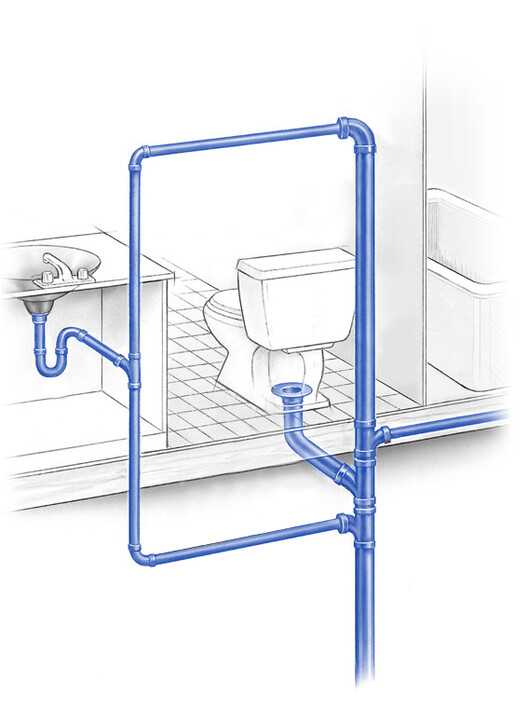Using the right pipe sizes and types helps avoid expensive problems down the road. DWV fittings have a wide range of functions, and there are many shapes and finishes.
For example, a tee can connect two pipes of different diameters or change the direction of a pipe run. But you can’t use a tee for every drain application: Some situations call for a wye or long sweep elbow.
Flow
Flowing plumbing lines need a minimum slope to minimize water turbulence and the deposition of entrained solids. This slope is typically 0.63 cm per foot in residential DWV systems.
Plumbing fixture groups and equipment rooms should be as close together as possible to minimize piping run lengths, which reduces installation time. The shorter the runs, the less likely they are to clash with large mechanical ductwork and electrical conduits in ceilings. This also prevents wasting space in ceilings and increases system efficiency.
A sanitary tee connects two pipes with a common inlet and outlet. It may combine equal or unequal pipe diameters or change the direction of a pipe run. Available in a variety of materials, sizes and finishes, tees are the most common type of fitting.
A nipple is a short stub of male-threaded steel, brass, chlorinated polyvinyl chloride (CPVC) or copper pipe that connects two other fittings. It is available with continuous uninterrupted threading, known as a close nipple, or with interrupted threads, known as a standard nipple. A nipple with smaller end threads concentric to the larger is known as a reducer.
Pressure
DWV fittings connect drain, waste and vent pipes in plumbing systems with constant water flow. They include elbows, tee-wyes, reducers and couplings. They come in a wide range of sizes and shapes, and are designed to meet varying requirements for residential piping systems.
For example, a coupling attaches two pipe segments at an angle with a small ridge that prevents over-insertion. A reducing coupling or reducer is used to change the diameter of one end of a pipe segment to match that of another pipe segment.
Most DWV systems have multiple water lines, including hot and cold lines for each shower and sink, and a main sewage line. The sewage line is heavier than the water line, so it requires extra reinforcement. It also needs a different type of fitting, called a wye or tee-wye, to join the main sewage line to the individual toilet and tub drains. Most DWV systems use flexible rubber fittings that can flex slightly, to absorb slight movements or stresses without transmitting them into the pipe system. They are secured to the pipe with stainless steel worm drive clamps.
Noise
When pipes are hung from the ceiling of a bathroom, they can vibrate against joists and studs and cause banging noise. Pipes can be secured to reduce this by using pipe straps or nailing wood blocks behind them. Alternatively, foam core PVC can provide an insulating barrier that will suppress noise.
Other sources of plumbing noise include water impacting against the drainage stack, thermal expansion and contraction of plastic piping and water hammers when valves close rapidly. Quieter sanitaryware can help mitigate these problems, as can eliminating pedestal toilets and replacing them with wall-hung fixtures.
Grooved fittings, such as those used in Geberit’s Silent-db20 pipework, are designed to reduce these noises. They have a groove cold-formed on the end of a pipe, with a gasket encompassed by coupling housing that engages the groove; this acoustic design deadens vibration and noise transmission. If a plumbing system has a number of small offsets and bends, a grooved fitting can also reduce the amount of water flowing into the pipe at these points, further reducing vibration and sound.
Temperature
There are different types of DWV fittings for water and sewage lines. Most bathrooms have hot and cold water lines for showers and sinks, as well as a drain line for the toilet. All of these lines converge on the main sewage line, which is wider than the water lines.
Flange fittings use a gasket to prevent leaks, and the type of gasket required depends on the pressure the joint must withstand. Polyisoprene and nitrile are common choices. Plumber’s putty can also be used to seal a flange connection, but this material may not hold up over time.
Slip-joint fittings have a detached slip nut and a washer, typically made of rubber or plastic. These can be tightened or loosened by hand, making them easier to access for residential drainpipe systems. Slip-joint elbows come in several styles, including long sweep and short arc types. They can take up less space and are useful in crowded pipes. However, it’s important to make sure there is enough room for the style of elbow you choose. Trying to squeeze elbows into tight spaces can create a kink in the pipe run.
Energy
In many homes, a large percentage of hot water sitting in pipes goes down the drain when someone turns on a shower or faucet, then leaves to do other tasks. This wastes a lot of water and energy. A sanitary tee is the right fitting for many drain applications, but a wye or long elbow may also be required to change direction in a pipe run.
A coupling, also known as a reducer or adapter, connects two pipes. It has a grooved surface that accepts the threads of a male or female pipe fitting, and a gasket encompassed by a coupling housing that engages the groove to seal the joint. A regular coupling has a small ridge or stops internally to prevent over-insertion of one pipe segment into the other.
A clean-out fitting allows a plumber to access a drain line without removing plumbing fixtures, and it should be placed at regular intervals in all drainage systems. These fittings are capped with plugs, but they can be unscrewed and removed to allow the passage of an auger or snake to clear blockages or clogs.

